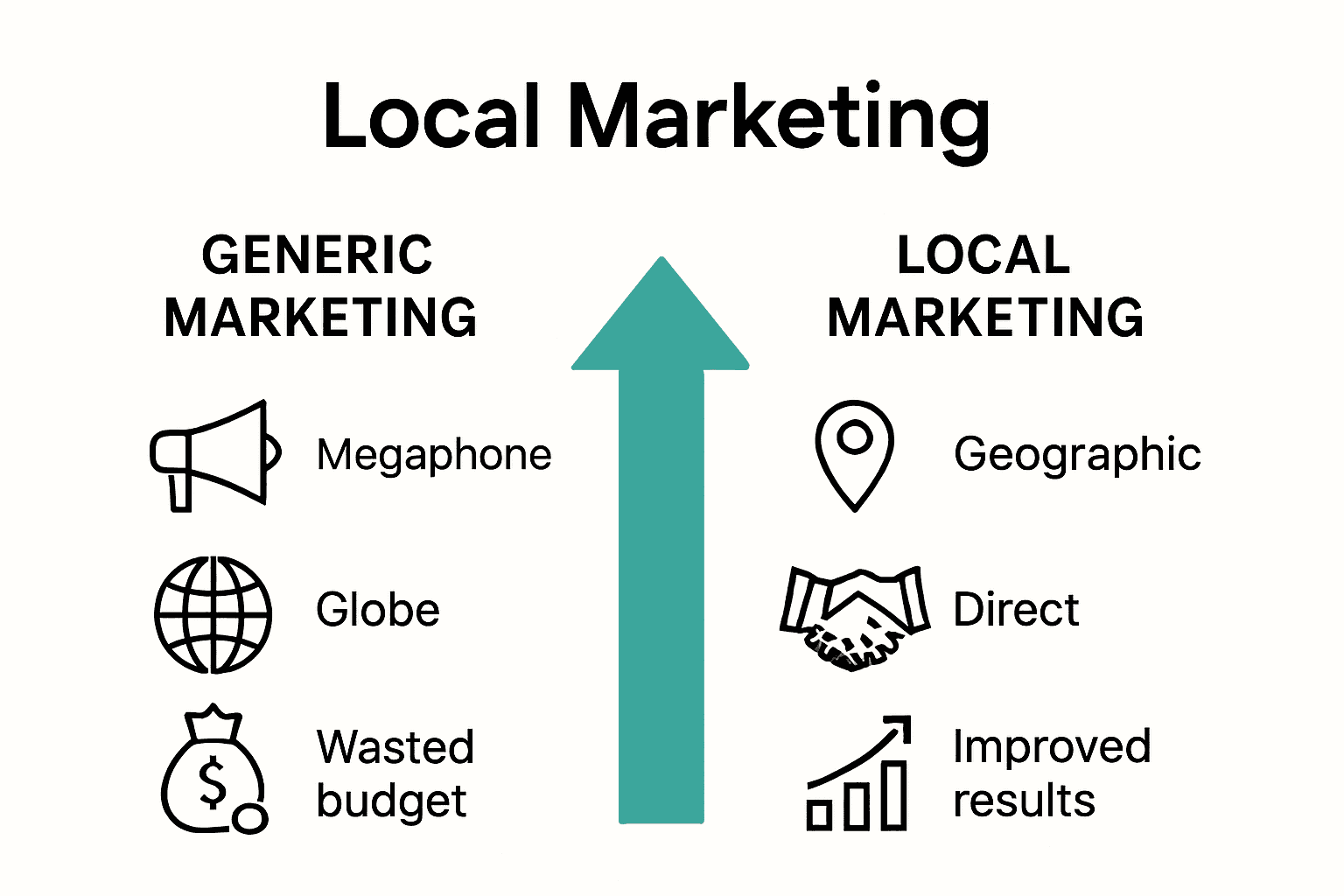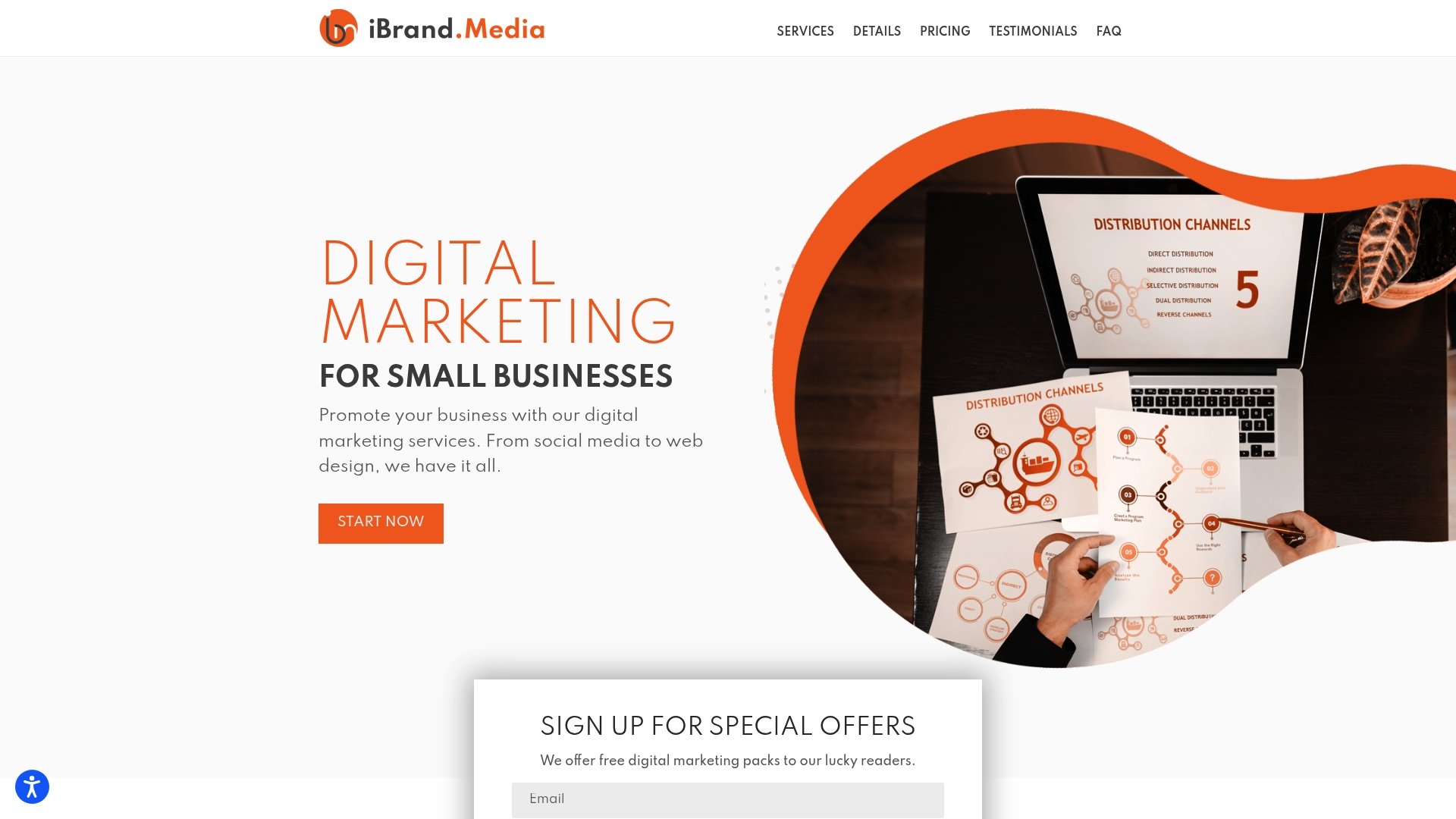Nearly 90 percent of consumers search online before visiting a local business, yet many owners miss out because their marketing does not reach the right people nearby. Local online marketing goes far beyond simply listing your address and hoping for the best. By learning how to connect directly with your community, you can capture valuable leads and stand out from the competition. This guide reveals practical steps for attracting more local customers and growing your business where it matters most.
Table of Contents
- Step 1: Define Your Local Audience And Market Area
- Step 2: Optimize Your Website For Local Search Results
- Step 3: Claim And Enhance Key Local Business Listings
- Step 4: Launch Targeted Local Advertising Campaigns
- Step 5: Engage Local Audiences On Social Media
- Step 6: Track Results And Refine Your Marketing Tactics
Quick Summary
| Key Point | Explanation |
|---|---|
| 1. Define your local audience clearly | Understand demographics to tailor marketing efforts effectively and identify customer behavior patterns. |
| 2. Optimize your website for local search | Use location-specific keywords and ensure mobile optimization for improved discoverability by local customers. |
| 3. Claim and enhance local business listings | Keep your business information accurate across platforms and encourage reviews to boost online visibility and credibility. |
| 4. Launch targeted local advertising | Use platforms like Google Ads to focus on specific demographics and craft localized messaging for better engagement. |
| 5. Track and adjust your marketing tactics | Regularly analyze performance data to refine strategies and stay responsive to changing marketing conditions. |
Step 1: Define Your Local Audience and Market Area
Knowing exactly who your local customers are and understanding the precise boundaries of your market area are fundamental steps in creating targeted online marketing strategies. By carefully mapping out your potential customer base, you can craft messages that resonate and reach the right people at the right time.
According to Small Business Development Center, understanding your local audience requires deep analysis of several key demographic factors. These include age ranges, income levels, cultural backgrounds, and specific purchasing behaviors unique to your region. Start by gathering data through methods like local census reports, community surveys, and analytics from your existing customer interactions. Look for patterns that reveal who your most likely customers are.
To define your market area effectively, examine geographical boundaries that make practical sense for your business. Consider factors such as driving distance, local economic conditions, and population density. A plumber might serve a 25mile radius, while a boutique restaurant might focus on a specific neighborhood or downtown district. Pro tip: Use mapping tools and local business association resources to help visualize and refine your market boundaries.
The goal is precision. Generic marketing wastes resources. By understanding exactly who your local customers are and where they live, you can create laser focused online marketing campaigns that speak directly to their needs and interests. Your next step will be developing targeted messaging that connects with this carefully defined audience.

Step 2: Optimize Your Website for Local Search Results
Making your website discoverable to local customers requires strategic optimization that helps search engines understand your business location and relevance. Your goal is to improve visibility so potential customers can find you easily when searching for services in your area.
According to Florida Atlantic University, enhancing local search visibility demands several key strategies. Start by incorporating location-specific keywords throughout your website content. This means mentioning your city, neighborhood, and service areas naturally within page titles, headings, and descriptive text. Ensure your business information is accurate and consistent across your website, including a prominently displayed local address and phone number.
Mobile optimization is critical for local search success. Most local searches happen on smartphones, so your website must load quickly and display perfectly on mobile devices. Purdue University recommends creating content that speaks directly to local events and community interests. This could include blog posts about neighborhood happenings, local customer success stories, or region-specific service offerings. Additionally, implement structured data markup to help search engines understand your business details and encourage customers to leave online reviews, which can significantly boost your local search rankings.
Remember that local search optimization is an ongoing process. Regularly update your content, monitor your search rankings, and stay connected with your local community online. Your next step will be developing a robust strategy for generating and managing local customer reviews.
Step 3: Claim and Enhance Key Local Business Listings
Claiming and optimizing your online business listings is crucial for increasing local visibility and attracting potential customers who are searching for services in your area. This process involves strategically managing your business profiles across multiple online platforms to ensure accurate and compelling representation.
According to the Small Business Development Center, claiming your business listings on key platforms like Google Business Profile is essential for accurate representation. Start by verifying your listings on major platforms such as Google, Yelp, Bing Places, and industry specific directories relevant to your business. During this process, ensure all information is consistent complete and up to date. This includes your business name, address, phone number, website, operating hours, and a detailed description of your services.
Enhance your business listings by adding high quality images that showcase your work, products, or business environment. Include professional photos of your team, workspace, and completed projects. Write a compelling business description that highlights your unique value proposition and includes location specific keywords. Encourage satisfied customers to leave reviews, as these can significantly improve your local search rankings and attract new clients. Pro tip: Respond to all reviews professionally showing potential customers that you value feedback and client relationships.
Remember that business listings are not a one time task. Regularly update your information, add fresh content, and monitor your online presence. Your next step will be developing a strategic approach to generating and managing customer reviews that boost your local credibility.
Step 4: Launch Targeted Local Advertising Campaigns
Targeted local advertising allows you to connect directly with potential customers in your specific market area, maximizing your marketing budget and increasing the likelihood of attracting qualified leads. This step is about strategically positioning your business in front of the right audience at the right time.
According to the Small Business Development Center, developing effective local advertising campaigns requires utilizing platforms like Google Ads and social media to reach specific demographics within your market area. Begin by defining your ideal customer profile using the demographic research from previous steps. Select advertising platforms that align with where your target audience spends their time online. For Google Ads, use location targeting to narrow your reach to specific cities or neighborhoods. On social media platforms like Facebook and Instagram, leverage detailed targeting options that allow you to filter audiences by location, age, interests, and behaviors.
Craft compelling ad copy that speaks directly to local customers by highlighting your unique local value proposition. Include location specific language, address local pain points, and showcase how your business solves problems for community members. Use high quality local imagery that resonates with your target market. Pro tip: Create different ad variations and run small test campaigns to determine which messaging and visuals generate the best engagement and conversion rates. Track your ad performance meticulously and be prepared to adjust your strategy based on real world data. Your next step will involve developing a systematic approach to measuring and optimizing your local advertising results.
Step 5: Engage Local Audiences on Social Media
Social media provides a powerful platform for connecting with local customers, building community relationships, and showcasing your business personality. Your goal is to transform your social media presence from a simple broadcasting channel into an interactive hub that resonates with local followers.
According to the Small Business Development Center, engaging local audiences requires sharing content that goes beyond standard marketing messages. Focus on highlighting community events, local news, and authentic customer stories that demonstrate your business’s deep roots in the neighborhood. Choose 2 3 social media platforms where your target audience is most active. For most local businesses, this means maintaining a strong presence on Facebook and Instagram, with potential expansion to platforms like TikTok or LinkedIn depending on your specific industry.
Create a content strategy that balances promotional posts with genuinely interesting local content. Share behind the scenes glimpses of your business, spotlight local team members, and celebrate community milestones. Develop a consistent posting schedule that keeps your audience engaged without overwhelming them. Pro tip: Respond to every comment and message promptly, treating each interaction as an opportunity to build trust and demonstrate your commitment to local customer service. Experiment with different content types like short videos, local event recaps, customer testimonials, and interactive polls to keep your social media feed dynamic and engaging. Your next step will involve developing a systematic approach to tracking social media engagement and refining your local online community strategy.
Step 6: Track Results and Refine Your Marketing Tactics
Successful local online marketing is an ongoing process of measurement, learning, and continuous improvement. Your ability to analyze performance data and make strategic adjustments will determine the long term effectiveness of your marketing efforts.
According to Purdue University, regularly analyzing your marketing performance helps identify successful tactics and areas for improvement. Set up comprehensive tracking using tools like Google Analytics, Google Search Console, and platform specific analytics from social media and advertising channels. Create a monthly performance dashboard that tracks key metrics such as website traffic, conversion rates, ad click through rates, social media engagement, and local search rankings. Pay special attention to metrics that directly impact your business goals like lead generation, phone calls, website form submissions, and actual revenue generated.
Establish a systematic review process where you evaluate your marketing performance at least quarterly. Compare your current results against previous periods and your initial benchmarks. Be prepared to pivot quickly make data driven decisions about which strategies to continue, modify, or abandon. Pro tip: Dont get too attached to any single marketing tactic. The digital marketing landscape changes rapidly, and what works today might not be as effective six months from now. Your success depends on staying agile and responsive to the data.
 The final step in your local online marketing journey is to continually educate yourself about emerging trends and technologies that can give your business a competitive edge.
The final step in your local online marketing journey is to continually educate yourself about emerging trends and technologies that can give your business a competitive edge.
Take Your Local Online Marketing to the Next Level with Expert Help
Struggling to define your local audience or optimize your website for local search? Many small businesses feel overwhelmed trying to master local SEO, targeted advertising, and social media engagement all at once. The article highlights how precision targeting and continuous improvement are essential to connect with nearby customers. If you want to stop wasting time and money on generic marketing and start seeing real results in your community, ibrand.media has the tailored solutions you need.

Discover how our affordable, personalized digital marketing services can help you precisely identify your market area, boost your local search rankings, and launch ad campaigns that speak directly to your customers’ needs. Visit our Uncategorized category to learn more about strategies that work. Ready to outshine your local competition? Connect with us today at ibrand.media and get a custom plan that drives immediate action.
Frequently Asked Questions
How can I define my local audience and market area for better online marketing?
Start by gathering data on key demographic factors like age, income, and purchasing behaviors specific to your region. Analyze local census reports and community surveys to identify patterns that reveal your potential customer base.
What are effective strategies to optimize my website for local search results?
Incorporate location-specific keywords throughout your website’s content, including titles and headings. Ensure your business information, like address and phone number, is consistent across all pages; aim to improve your website speed and mobile usability within 30 days.
How do I claim and enhance my local business listings?
Begin by verifying your business on major platforms such as Google Business Profile and Yelp. Ensure all information is accurate, complete, and visually appealing with high-quality images; update these listings regularly to maintain visibility.
What are the best methods for launching targeted local advertising campaigns?
Utilize platforms like Google Ads and social media to define your ideal customer profile based on demographic research. Craft location-specific ad copy and images, then test different variations to determine which perform best within the first few weeks of your campaign.
How can I engage with local audiences on social media?
Share community-focused content and authentic customer stories instead of just promotional posts. Choose 2-3 social media platforms that suit your target audience and develop a consistent posting schedule to maintain engagement over time.
What steps should I take to track the results of my local online marketing efforts?
Implement tracking tools to monitor key performance metrics such as website traffic and conversion rates. Establish a quarterly review process to evaluate your strategies and be ready to modify actions based on your findings for better performance.
Recommended
- Boost Your Revenue: Increasing Local Sales Online | Ibrandmedia
- Targeting Local Customers Online: Proven Strategies for 2025 | Ibrandmedia
- Top Benefits of Local Marketing for Small Businesses 2025 | Ibrandmedia
- How to Run Local Ads: A Complete Guide for 2025 | Ibrandmedia
- Guide to Dominating Local Search and Driving Quality Traffic | Kickass Online

Recent Comments